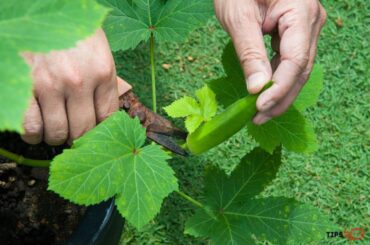I have epimedium in my garden and it is so easy to care for. Therefore I want to share these easy Epimedium care tips with you. First, let me tell you something special about this plant. Epimedium belongs to the herbaceous genus which belongs to the barberry family. Normally plants belonging to the barberry family are invasive. However, what is good about these plants is that they don’t have any invasive characteristics like other woody plants in their family.
Epimedium care is quite an easy task. Epimedium plant species originate from the Mediterranean region and they would come up with their showy foliage all year long. That said, it would be best if you could mimic the same conditions they get in the woodlands when you cultivate them so that it would be easy for them to thrive.

Some of the common names of these plants are; barrenwort, bishop’s hat and fairy wings. They have inherited the common name called barrenwort as some people believed that it would result in barrenness in women. Further, they have got the common name called bishop’s hat as Epimedium flowers tend to look like a clergyman’s mitered hat. Lastly, Epimedium dainty flower blossoms would hover above the foliage just like the way the butterflies and fairy wings do and due to that, they have earned the name called fairy wings.
The sizes and the appearances of the Epimedium plants
If you know a lot about the Epimedium plant and its appearance, you can skip this part and go straight to the caring part. But if you are a novice to Epimedium gardening you should read this bit. In terms of the sizes of the Epimedium plants, they would get as tall as 8 inches to 12 inches.
Further, they could either form as low mounds or even gently spread as the ground covers too. Epimedium plant leaves would tend to take a heart shape most of the time. They are so graceful and add so much glamor to the overall look of the plants. There could be various Epimedium plant species that would come up in various sizes as well as in colors.
For example, Epimedium stellutatum would come up with elongated leaves and they tend to resemble the look of arrowheads. Once the spring comes, you could spot the Epimedium plants coming up in a wide array of colors. However many Epimedium plants would form with reddish coloring or with markings. That said, if we consider Epimedium youngianum plants, they would usually come up with magnificent spring foliage. Once the foliage grows older, you could spot them becoming solid green in summer or in green with some reddish markings.
On the other hand, if we consider Epimedium sempervirens plants, you could spot them coming up with clusters of flowers during early spring on long arching scapes. Those flowers would arise in numerous colors such as white, red, pink, purple yellow and in orange as well. further chances are that they may come up in bi-color combinations as well. Some people try hybridizing the plants to expand the floral color palette too. However, there could be some people who are fans of the amazing foliage of those plants rather than the delicate flowers of those.
Furthermore, Epimedium versicolor plants usually contain yellow flower blossoms. When they produce flowers during spring, you could see them carrying rusty red markings and it would make the plants look more attractive.
Origins of the Epimedium plants
In terms of origins, they are from around the Mediterranean sea and eastern Asia. The Epimedium species around the Mediterranean area would usually be evergreen. Further, they can survive in drought conditions once they get established too. Having said that, the Epimedium species which you come across in the Asia region do not survive in drought conditions like the Epimedium species in the Mediterranean sea region.
Furthermore, those plants would tend to perish in fall and reappear in spring along with some striking variations in their foliage, texture and in color as well.

Epimedium care guide
When you plant them, consider planting them exposed to a dappled shade of trees and with some leaf mulch. So ideally you need to plant them closer to trees and consider adding compost or even leaf mold so that it would be beneficial for the plant’s healthy growth and for their survival.
Sunlight requirement of the Epimedium plants
Epimedium plants would prefer to grow in locations where they can gain partial sunlight or dappled lighting. Epimedium plants would make great shade garden plants. However, they are not the type of plants that would survive in fully sunny locations. Hence, I suggest you grow these plants under trees or even near larger structures so that they can gain shade and not harsh intense sunlight.
Soil requirement of the Epimedium plants
If you have dry rocky soil where you find it difficult to find perfect plants which would suit those, Epimedium plants would be quite handy for you. As aforesaid the Mediterranean Epimedium plants are used to grow in drought conditions. As such I suggest you grow them near trees so that it would allow their roots to develop firmly as well.
Despite the fact that Epimedium plants can grow in dry rocky soil, it is always best to provide them with fertile soil which has excellent draining facilities as well. Keep in mind that these plants don’t opt to grow in soggy conditions. Hence, it is very vital that you provide a soil mix that has an excellent draining facility. When it comes to the right pH levels of the Epimedium plants, it would vary on the Epimedium variety. That being said, neutral or slightly acidic soil would suit these plants generally.
Water requirement of the Epimedium plants
As mentioned above, Epimedium plants are used to grow in drought conditions. Therefore, they could survive with regular watering until they get established. However, once they are mature and established, you don’t even need to water them regularly.
Furthermore, when you water them, you should water them only if their soil is dry. Besides, once you water them you need to make sure that you allow their excess water to drain. it is important that you don’t allow for any water build-up in the plants as then it would create soggy conditions for the plants.
Temperature and humidity requirement of the Epimedium plants
Epimedium plants are hardy little plants that you can grow in USDA hardiness zones five to eight. Further, they can withstand a wide array of temperatures too. Not only that but also they can survive in a wide array of humidity levels as well. Having said that, it is noteworthy that Epimedium plants would not withstand intense heat from the summer as it may be harmful to the leaves.
Fertilizer requirement of Epimedium plants
These plants are used to grow in woodland areas or beneath trees. Hence it would be best to grow them in compost or leaf mold into the soil. Apart from that, you may add a slow-release fertilizer instead of compost during spring.
How to prune the Epimedium plants
You can consider pruning only the evergreen Epimedium plants. The perfect time to prune the Epimedium plants would be early spring right before they come up with the flowers. There could be certain Epimedium plants that don’t shed their leaves. Hence I recommend you trim those leaves so that it would encourage fresh healthy growth of the plants. Consequently, you could see them flourishing magnificently.
Potting and repotting of Epimedium plants.
Epimedium plants are growing at a slow pace. Further, these are hardy sets of plants which would make them a perfect choice for container gardening. However, when you choose a container to grow them, you need to go ahead with a container that has draining holes so that it would allow the excess water to flow out.
Next, make sure that you add compost or leaf mold to the bottom of the pot before you plant them and make it moist and not waterlogged. On the other hand, when you spot these plants that have outgrown the pots, you need to remove these plants and divide them.

How do you overwinter the Epimedium plants?
Epimedium plants can withstand cold winter conditions pretty well. That said there could be some Epimedium varieties that would perish during winter whereas there could be some Epimedium plants that would stay evergreen. Due to these reasons, it is not necessary to provide any extra attention to make them thrive in winter given that you have grown them in appropriate USDA hardiness zones.
How to encourage Epimedium plants to bloom
Epimedium plants usually bloom during spring. Thus, it is important that you provide compost or even fertilizers during spring. Furthermore, ensure that you provide the right growing conditions to encourage them to bloom.
Epimedium plants come up with delicate flowers and they may contain four petals. Further as above mentioned they would tend to look like they are hovering above the plants. You could spot them coming up in a wide array of colors as the flower color would vary depending on the Epimedium variety.
For example, they would come up in red, pink, orange yellow purple and in white as well. There could be some Epimedium flowers with spiky petals. Further, there could be some with smooth round petals. Irrespective of the nature of the flower petals, it would ensure that they add more glamor and elegance to the Epimedium plants.
Common problems you may come across when growing the Epimedium plants.
Epimedium plants grow well with minimum supervision from you. However, there could be animal species such as rabbits, slugs snails that would tend to invade these plants on and off. For example, Rabbits would nibble the foliage of the plants while slugs and snails would chew the foliage. However, it is very unlikely that they would do any major damage to an established or mature plant.
Apart from that, Epimedium plants may come across diseases such as root rot too. If you happen to overwater them or end up using a poor draining soil mix chances are that the plants may suffer from root rot. In addition to that, Epimedium plants may also come across discolored wilted leaves as well. Once the Epimedium plants start to suffer from root rot, you could spot them carrying discolored, yellowed wilted small leaves.
Not only that but also they would develop soggy stems and dark soft roots as well. To remedy this what you could do is remove the plants and snip off the infected areas. Furthermore, you can consider using soil amendments such as compost, and sand so that it would enhance the drainage of the soil mix.
How to propagate the Epimedium plants
Dividing the Epimedium plants is the most commonly used propagation method. Furthermore, in terms of the right season to conduct the propagation, I recommend you do it in spring and fall. You need to arrange a pair of gloves, a shovel, or a pair of garden snips.
First and foremost, you need to loosen the soil around the plant by using a shovel. Once it is done, you could simply remove the root structure of the plants and remove the plants as well. Now you could make use of the shovel and the snips and cut through the plant’s roots system and do the division. However, when you do this, make sure that each division carries a healthy root system as well as healthy foliage.
Next, you need to plant them in an appropriate location. Epimedium plants require good drainage in the soil medium and protection from strong sunlight. literally, you need to mimic the same conditions they get in the natural habitats when you plant them as well.
How to grow Epimedium plants from seeds.
Propagating the Epimedium plants via seeds is a fairly easy and rapid process. Having said that, you cannot rely on the fact that the newly planted Epimedium plant would look the same as the parent plant. In other words, it is very likely that they would come up with different characteristics than the mother plants. So, if you are someone who wishes to have the same plants as the mother plant, division would be the best propagation method to do. However, if you wish to practice the seeds propagation method, you could follow the below steps.
First, you need to obtain the seeds from the Epimedium plants. Usually, the seeds would drop when they are green and it is very likely that you would miss them. So, when they come up with seeds, collect them as soon as possible without letting them dry. Next place them in a soil layer whilst ensuring that you don’t bury them too deep as well. Besides, it is always best to do this outdoors. That said, if you have planted the seeds indoors I suggest you keep the pots in the refrigerator for about three months.
If you have planted the seeds outdoors they would start to germinate during the spring. On the other hand, if you have placed them indoors, germination would start to form once you remove them indoors. Always keep the soil moist and not waterlogged. Further, you can consider planting outdoors if the outdoor weather conditions are healthy and no risk of frost.
What are the benefits of the Epimedium plants?
Epimedium plants would make great container plants especially when you grow them along with shade garden plants. Furthermore, they would be great ground covers as well as for rock garden plants. They would be handy to use for edging in the rock gardens. Apart from that, they would be great picks for woodland gardens too. Epimedium plants would make great pairs with plants like Gallium, Ferns Hostas or Primulas.

How do you use Epimedium plants for landscaping
You could use Epimedium plants in so many ways for landscaping. If you have a mixed shade garden, you could use them as perfect ground covers as they can fill the gaps between the trees and the shrubs. Literally, they would act as a layer of living mulch. Apart from that, you could plant them as borders on woodland paths. The Epimedium plants foliage would be perfect fit for the edges of the pathways.
Suppose that you have a shade garden that contains taller plants, you could consider using lower-growing Epimedium plants. I suggest you choose small heart or arrowhead-shaped plants as they would make a perfect addition for lawn and garden plantings. Besides, you could consider planting the Epimedium plants as accompaniments to spring bulbs too. That way you could add so much glamor and texture to the spring bulb setup. Additionally, it would help to hide whatever the decaying dying bulb foliage as well.
Furthermore, you could make use of these plants as a solution for erosion as well. Epimedium plants contain a dense root system. Hence it can hold onto the soil and make them contained. That said, if you have a large surface, Epimedium plants would not be the one as they are slow-growing plants. In addition, Epimedium plants are somewhat costly to use for ground covers and not many people will be able to afford them.
Are Epimedium plants poisonous?
Epimedium plants could be mildly toxic. That said, there are some people who use some parts of the Epimedium plants to cook. Furthermore, our ancestors had used the extracts of the Epimedium grandiflorum to remedy some cancer types. Moreover, Epimedium plants such as Epimedium macun and Epimedium brevicornum are useful to treat thyroid problems as well. Not only that but also, people have used them to overcome high blood pressure and erectile dysfunction as well. You can commonly spot the traditional Chinese people using them as herbal medicine.
Related questions
Do Epimedium plants spread?
Epimedium plants are regarded as spreading ground plants but at a slow pace. Furthermore, they don’t have any invasive qualities like the other ground cover plants.
Can you consider Epimedium plants as evergreen plants?
Some Epimedium plants are evergreen while others are not. Nonevergreen plants perish in winter. For example, the Asian Epimedium plants die during winter while the Mediterranean Epimedium plants stay evergreen.
Where do Epimedium plants usually grow?
Epimedium plants are endemic to Asia and the Mediterranean regions. Woodland areas would be their natural habitats in general.
Conclusion
I am sure now you understand Epimedium plants are such versatile plants and anybody can grow them. They would last for a longer period and would want only a little maintenance from you. They are hardy in drought conditions and resistant to deer as well. The two highlights of these plants are their beautiful flowers as well as the foliage. You have a lot of Epimedium plant varieties to choose from and they would never fail to amaze you with their beauty.
Read Next : Does Lavender Plant Like Sun Or Shade? ( Mystery Solved )




